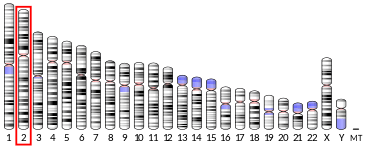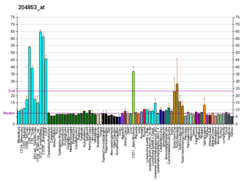ORC2
Origin recognition complex subunit 2 is a protein that is encoded by the ORC2 (ORC2L) gene in humans.[5][6]
| Origin recognition complex subunit 2 | |||||||||
|---|---|---|---|---|---|---|---|---|---|
| Identifiers | |||||||||
| Symbol | ORC2 | ||||||||
| Pfam | PF04084 | ||||||||
| InterPro | IPR007220 | ||||||||
| |||||||||
Function
The origin recognition complex (ORC) is a highly conserved six subunits protein complex essential for the initiation of the DNA replication in eukaryotic cells. Studies in yeast demonstrated that ORC binds specifically to origins of replication and serves as a platform for the assembly of additional initiation factors such as Cdc6 and Mcm proteins. The protein encoded by this gene is a subunit of the ORC complex. This protein forms a core complex with ORC3, ORC4, and ORC5. It also interacts with CDC45L and MCM10, which are proteins known to be important for the initiation of DNA replication. This protein has been demonstrated to specifically associate with the origin of replication of Epstein-Barr virus in human cells, and is thought to be required for DNA replication from viral origin of replication.[6]
Interactions
ORC2 has been shown to interact with:
References
- GRCh38: Ensembl release 89: ENSG00000115942 - Ensembl, May 2017
- GRCm38: Ensembl release 89: ENSMUSG00000026037 - Ensembl, May 2017
- "Human PubMed Reference:". National Center for Biotechnology Information, U.S. National Library of Medicine.
- "Mouse PubMed Reference:". National Center for Biotechnology Information, U.S. National Library of Medicine.
- Takahara K, Bong M, Brevard R, Eddy RL, Haley LL, Sait SJ, Shows TB, Hoffman GG, Greenspan DS (October 1996). "Mouse and human homologues of the yeast origin of replication recognition complex subunit ORC2 and chromosomal localization of the cognate human gene ORC2L". Genomics. 31 (1): 119–122. doi:10.1006/geno.1996.0018. PMID 8808289.
- "Entrez Gene: ORC2L origin recognition complex, subunit 2-like (yeast)".
- Kneissl M, Pütter V, Szalay AA, Grummt F (March 2003). "Interaction and assembly of murine pre-replicative complex proteins in yeast and mouse cells". J. Mol. Biol. 327 (1): 111–28. doi:10.1016/s0022-2836(03)00079-2. PMID 12614612.
- Méndez J, Stillman B (November 2000). "Chromatin association of human origin recognition complex, cdc6, and minichromosome maintenance proteins during the cell cycle: assembly of prereplication complexes in late mitosis". Mol. Cell. Biol. 20 (22): 8602–12. doi:10.1128/mcb.20.22.8602-8612.2000. PMC 102165. PMID 11046155.
- Izumi M, Yanagi K, Mizuno T, Yokoi M, Kawasaki Y, Moon KY, Hurwitz J, Yatagai F, Hanaoka F (December 2000). "The human homolog of Saccharomyces cerevisiae Mcm10 interacts with replication factors and dissociates from nuclease-resistant nuclear structures in G(2) phase". Nucleic Acids Res. 28 (23): 4769–77. doi:10.1093/nar/28.23.4769. PMC 115166. PMID 11095689.
- Fujita M, Ishimi Y, Nakamura H, Kiyono T, Tsurumi T (March 2002). "Nuclear organization of DNA replication initiation proteins in mammalian cells". J. Biol. Chem. 277 (12): 10354–61. doi:10.1074/jbc.M111398200. PMID 11779870.
- Vashee S, Simancek P, Challberg MD, Kelly TJ (July 2001). "Assembly of the human origin recognition complex". J. Biol. Chem. 276 (28): 26666–73. doi:10.1074/jbc.M102493200. PMID 11323433.
- Méndez J, Zou-Yang XH, Kim SY, Hidaka M, Tansey WP, Stillman B (March 2002). "Human origin recognition complex large subunit is degraded by ubiquitin-mediated proteolysis after initiation of DNA replication". Mol. Cell. 9 (3): 481–91. doi:10.1016/s1097-2765(02)00467-7. PMID 11931757.
- Dhar SK, Delmolino L, Dutta A (August 2001). "Architecture of the human origin recognition complex". J. Biol. Chem. 276 (31): 29067–71. doi:10.1074/jbc.M103078200. PMID 11395502.
- Matsuoka S, Ballif BA, Smogorzewska A, McDonald ER, Hurov KE, Luo J, Bakalarski CE, Zhao Z, Solimini N, Lerenthal Y, Shiloh Y, Gygi SP, Elledge SJ (May 2007). "ATM and ATR substrate analysis reveals extensive protein networks responsive to DNA damage". Science. 316 (5828): 1160–6. doi:10.1126/science.1140321. PMID 17525332.
- Pinto S, Quintana DG, Smith P, Mihalek RM, Hou ZH, Boynton S, Jones CJ, Hendricks M, Velinzon K, Wohlschlegel JA, Austin RJ, Lane WS, Tully T, Dutta A (May 1999). "latheo encodes a subunit of the origin recognition complex and disrupts neuronal proliferation and adult olfactory memory when mutant". Neuron. 23 (1): 45–54. doi:10.1016/s0896-6273(00)80752-7. PMID 10402192.
- Quintana DG, Hou Zh, Thome KC, Hendricks M, Saha P, Dutta A (November 1997). "Identification of HsORC4, a member of the human origin of replication recognition complex". J. Biol. Chem. 272 (45): 28247–51. doi:10.1074/jbc.272.45.28247. PMID 9353276.
- Quintana DG, Thome KC, Hou Zh, Ligon AH, Morton CC, Dutta A (October 1998). "ORC5L, a new member of the human origin recognition complex, is deleted in uterine leiomyomas and malignant myeloid diseases". J. Biol. Chem. 273 (42): 27137–45. doi:10.1074/jbc.273.42.27137. PMID 9765232.
Further reading
- Gavin KA, Hidaka M, Stillman B (1996). "Conserved initiator proteins in eukaryotes". Science. 270 (5242): 1667–1671. doi:10.1126/science.270.5242.1667. PMID 7502077.
- Saha P, Thome KC, Yamaguchi R, Hou Z, Weremowicz S, Dutta A (1998). "The human homolog of Saccharomyces cerevisiae CDC45". J. Biol. Chem. 273 (29): 18205–18209. doi:10.1074/jbc.273.29.18205. PMID 9660782.
- Ritzi M, Baack M, Musahl C, Romanowski P, Laskey RA, Knippers R (1998). "Human minichromosome maintenance proteins and human origin recognition complex 2 protein on chromatin". J. Biol. Chem. 273 (38): 24543–24549. doi:10.1074/jbc.273.38.24543. PMID 9733749.
- Pinto S, Quintana DG, Smith P, Mihalek RM, Hou ZH, Boynton S, Jones CJ, Hendricks M, Velinzon K, Wohlschlegel JA, Austin RJ, Lane WS, Tully T, Dutta A (1999). "latheo encodes a subunit of the origin recognition complex and disrupts neuronal proliferation and adult olfactory memory when mutant". Neuron. 23 (1): 45–54. doi:10.1016/S0896-6273(00)80752-7. PMID 10402192.
- Jiang W, McDonald D, Hope TJ, Hunter T (1999). "Mammalian Cdc7-Dbf4 protein kinase complex is essential for initiation of DNA replication". EMBO J. 18 (20): 5703–5713. doi:10.1093/emboj/18.20.5703. PMC 1171637. PMID 10523313.
- Natale DA, Li CJ, Sun WH, DePamphilis ML (2000). "Selective instability of Orc1 protein accounts for the absence of functional origin recognition complexes during the M-G(1) transition in mammals". EMBO J. 19 (11): 2728–2738. doi:10.1093/emboj/19.11.2728. PMC 212765. PMID 10835370.
- Thome KC, Dhar SK, Quintana DG, Delmolino L, Shahsafaei A, Dutta A (2001). "Subsets of human origin recognition complex (ORC) subunits are expressed in non-proliferating cells and associate with non-ORC proteins". J. Biol. Chem. 275 (45): 35233–35241. doi:10.1074/jbc.M005765200. PMID 10954718.
- Izumi M, Yanagi K, Mizuno T, Yokoi M, Kawasaki Y, Moon KY, Hurwitz J, Yatagai F, Hanaoka F (2001). "The human homolog of Saccharomyces cerevisiae Mcm10 interacts with replication factors and dissociates from nuclease-resistant nuclear structures in G(2) phase". Nucleic Acids Res. 28 (23): 4769–4777. doi:10.1093/nar/28.23.4769. PMC 115166. PMID 11095689.
- Vashee S, Simancek P, Challberg MD, Kelly TJ (2001). "Assembly of the human origin recognition complex". J. Biol. Chem. 276 (28): 26666–26673. doi:10.1074/jbc.M102493200. PMID 11323433.
- Dhar SK, Delmolino L, Dutta A (2001). "Architecture of the human origin recognition complex". J. Biol. Chem. 276 (31): 29067–29071. doi:10.1074/jbc.M103078200. PMID 11395502.
- Dhar SK, Yoshida K, Machida Y, Khaira P, Chaudhuri B, Wohlschlegel JA, Leffak M, Yates J, Dutta A (2001). "Replication from oriP of Epstein-Barr virus requires human ORC and is inhibited by geminin". Cell. 106 (3): 287–296. doi:10.1016/S0092-8674(01)00458-5. PMID 11509178.
- Izumi M, Yatagai F, Hanaoka F (2002). "Cell cycle-dependent proteolysis and phosphorylation of human Mcm10". J. Biol. Chem. 276 (51): 48526–31. doi:10.1074/jbc.M107190200. PMID 11602595.
- Fujita M, Ishimi Y, Nakamura H, Kiyono T, Tsurumi T (2002). "Nuclear organization of DNA replication initiation proteins in mammalian cells". J. Biol. Chem. 277 (12): 10354–10361. doi:10.1074/jbc.M111398200. PMID 11779870.
- Schaarschmidt D, Ladenburger EM, Keller C, Knippers R (2002). "Human Mcm proteins at a replication origin during the G1 to S phase transition". Nucleic Acids Res. 30 (19): 4176–4185. doi:10.1093/nar/gkf532. PMC 140533. PMID 12364596.
- Matheos D, Ruiz MT, Price GB, Zannis-Hadjopoulos M (2002). "Ku antigen, an origin-specific binding protein that associates with replication proteins, is required for mammalian DNA replication". Biochim. Biophys. Acta. 1578 (1–3): 59–72. doi:10.1016/S0167-4781(02)00497-9. PMID 12393188.
- Kneissl M, Pütter V, Szalay AA, Grummt F (2003). "Interaction and assembly of murine pre-replicative complex proteins in yeast and mouse cells". J. Mol. Biol. 327 (1): 111–128. doi:10.1016/S0022-2836(03)00079-2. PMID 12614612.
External links
- PDBe-KB provides an overview of all the structure information available in the PDB for Human Origin recognition complex subunit 2 (ORC2)




